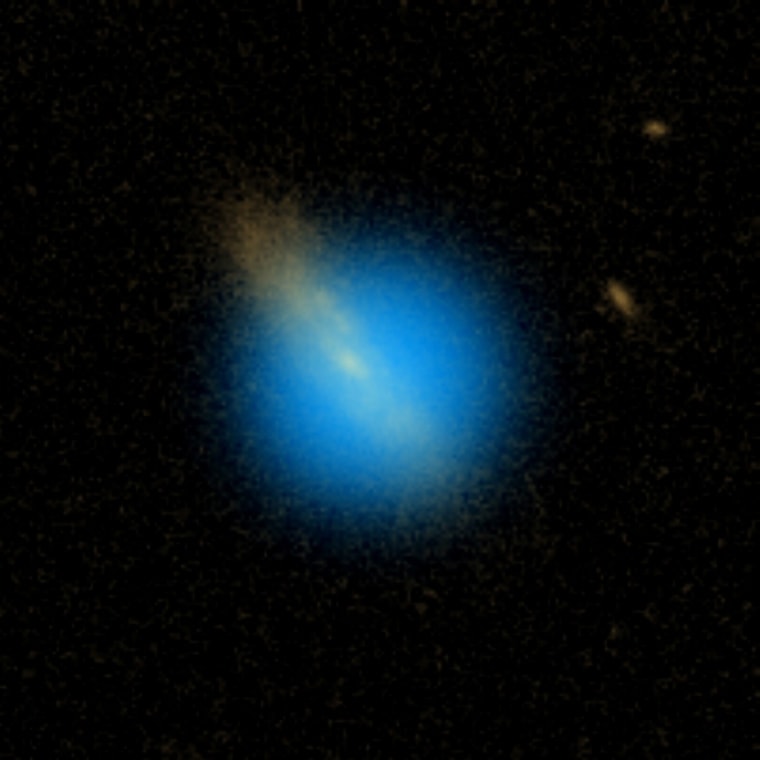Like a cosmic Grim Reaper, a blast of ultraviolet light signals the violent death of the universe's most massive stars. Now astronomers have viewed this heavenly harbinger for the first time.
"Astronomers have been dreaming about seeing the first light from the violent death of a star for over 30 years," said lead researcher Kevin Schawinksi of the University of Oxford. "Our observations open up an entirely new avenue for studying the final stages in the lives of massive stars and the physics of supernovae."
Schawinski and his colleagues detected the ultraviolet signal of a hefty star on the verge of explosion, which they detail in Friday's issue of the journal Science.
Usually, when astronomers see a supernova, the star has already been destroyed. "It's very hard to tell much about precisely the kind of star that actually died there," Schawinski told Space.com. "The really cool thing about our observations is this light traveling ahead of the shock wave traveled through the star before it was destroyed."
He added, "It's telling us about the properties, the conditions, of the star at the moment it died, but before the shock wave actually disrupted it."
Watching a doomed star
When a massive star, weighing at least 10 suns, runs out of nuclear fuel, it can collapse under its own weight, triggering an explosion called a supernova. The explosion sends the stellar guts spewing away at 20 million mph (10,000 kilometers per second) in a fireball that's a billion times brighter than the sun, the researchers say.
It's this fireball that scientists observe. What they haven't seen until now are the final moments of the doomed star just before the visible explosion. For the past 30 years or so, theorists have predicted a surge of ultraviolet light should come before the actual visible explosion.
There are several problems for actually seeing this phenomenon. "By the time you see the supernova, it's already days or weeks in the past," Schawinski said. "If you see a supernova you'd have to go back in time. You'd have to be already looking at the position."
The other issue is the fact that Earth's atmosphere absorbs ultraviolet light, and so you'd need a space telescope to view the death beacon. The answer came in the form of the Galaxy Evolution Explorer, or GALEX, which orbits Earth about every 98.6 minutes and views the universe in ultraviolet.
With GALEX, researchers recently got front-row seats to the pre-show of what they suspect was a red supergiant star measuring somewhere between 500 and 1,000 solar radii, on the verge of explosion. A red supergiant is a hefty star nearing the end of its life that can swell to 100 times its original size before exploding.
Schawinski and his colleagues looked at GALEX images taken at the positions of supernovae previously identified with optical telescopes in Hawaii.
"We found a new source at the location of one supernova, suddenly outshining its galaxy host in the UV," said Mark Sullivan of the University of Oxford. "It appeared a couple of weeks before the optical discovery of the supernova and marked the first stage in the death of the star."
The final hours
The UV peak represented a unique phase in the formation of the supernova SNLS-04D2dc, just before the shock wave from its collapsed core reached the star's surface to violently eject its shell of hot gas.
During a red supergiant's final hours, a shock wave whizzes outward with the related radiation moving even faster and heating up the star's surface. The temperature at the surface ramps up from a few thousand degrees Celsius to several hundred thousand degrees. Just before the shock wave catches up and reaches the surface (triggering a supernova), the star is producing the same total luminosity as a thousand billion suns, the researchers say.
Once the shock wave catches up, it plows through the outer parts of the star, accelerating several suns' worth of material outward. The surface of the star explodes. A few days later, supernova hunters will spot the bright visible light of the explosion.
Schawinski describes the observations as looking inside of a semi-transparent star as it's dying.
"We saw the whole thing. We saw the radiative precursor, this UV light, moving ahead [of the shock wave]," Schawinski said. "We saw that arrive and then the point at which the shock wave comes to the surface and destroys the star. In a sense we could see the shock move inside the star because the light from the shock was moving ahead of it."
The new UV peak findings, the astrophysicists say, will shed light on deathly details once hidden beneath a star's outer cloak.
"This is a whole new avenue into studying the late stages of massive stars," said Oxford researcher Christian Wolf. "Most of what we know today is based on computer simulations. But as always when you test theory against observations for the first few times, we may be in for surprises."
